XFlow Reveals Virus Pollution Dispersion at Thunder God Mountain Hospital
A novel coronavirus, also known as the NCP-2019 and COVID-19, has rapidly spread across China, especially prevalent in the Wuhan province located in the middle of the country. The leaders of the World Health Organization praised China’s response to the ongoing outbreak, where more than 32,000 dedicated medical faculty have volunteered to combat the virus. However, the Chinese Center for Disease Control and Prevention estimates over 3,000 medical faculty were already exposed to the virus before Feb 17, 2020. Dassault Systèmes’ SIMULIA solution XFlow is helping to prevent cross-infection between the patient and assisting medical faculty by revealing how virus pollution dispersion acts in a patient room.
Center-South Architectural Design Institute (CSADI) designs the hospital layout quickly, and pays close attention to potential environmental pollution. CSADI, Dassault Systèmes, Jiangda Tech, and the Shanghai Supercomputer Center have established a collaborative, virtual simulation team with the goal of suppressing cross-infection currently evaluated at the highest level due to tremendous amounts of COVID-19 infections. Virus pollution dispersion, as well as internal ventilation systems, were simulated using XFlow, an advanced computational fluid dynamics software solution that was acquired by Dassault Systèmes in 2016. The simulation showed pollution concentration near the patient as well as the medical faculty even with different HVAC ventilation layouts, which provides valuable solutions for pollution concentration control for current and future hospital constructions.
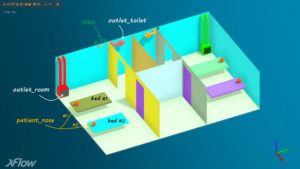
CSADI and Dassault Systèmes designed four HVAC ventilation layouts corresponding to the engineering experience shown in figure 2. The A-layout has incoming airflow from the lateral top and the ventilation outlet located in the corner of the room under the same side; the B-layout has incoming airflow from the ceiling lateral top and the ventilation outlet located in a corner on the other side of the room; the C-layout has incoming airflow from the middle of the ceiling at the top and the ventilation outlet located in two corners of the room; and the D-layout has incoming airflow from the middle of the ceiling at the top and the ventilation outlet located above the patient’s head. It is worth noting that high efficiency pollution filters have been installed inside the ventilation outlet.
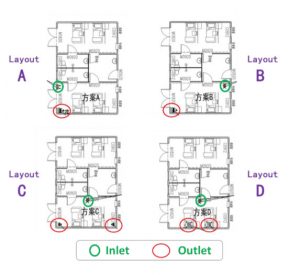
The test points for the patient (H=0.75m) and medical faculty (H=1.5m) were set in order to output transient virus pollution concentration. Figure 3 illustrates pollution concentration distribution under 0.75m high in the section corresponding to different ventilation layouts. The results demonstrated that the A-layout was capable of suppressing pollution dispersion, which was forced convection with airflow directly to the ventilation outlet. However, other layouts showed severe pollution dispersion inside the entire room.
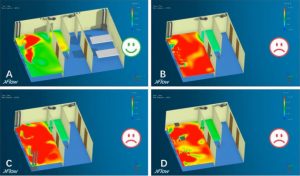
Detailed analysis of the flow field comparison demonstrated a “U-type” ventilation path in the patient’s room corresponding to the A-layout solution. Figure 4 illustrates mainstream path releases from the ventilation inlet, and flow towards the patient’s head area directly after collision with the lateral wall.
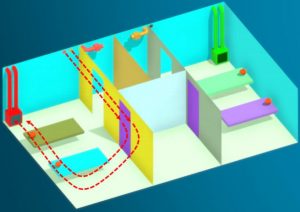
Figure 5. shows a dynamic animation corresponding to a transient “U-type” ventilation path line.
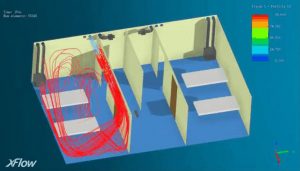
Virus pollution was a forced convection to ventilation outlet under the “U-type” ventilation corresponding to A-layout demonstrated by the transient pollution dispersion animation output from XFlow postprocessing.
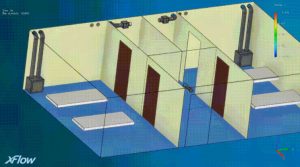
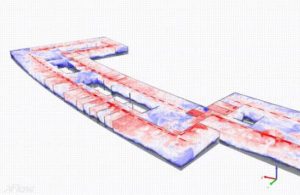
Reference: XFlow CFD is a fast and accurate CFD code based on the Lattice Boltzmann Approach. It offers you the most accurate and advanced Computational Fluid Dynamics Technology for real-world industrial applications, such as smart cities, metal building HVAC, and firefighting systems, etc.
SIMULIA offers an advanced simulation product portfolio, including Abaqus, Isight, fe-safe, Tosca, Simpoe-Mold, SIMPACK, CST Studio Suite, XFlow, PowerFLOW and more. The SIMULIA Learning Community is the place to find the latest resources for SIMULIA software and to collaborate with other users. The key that unlocks the door of innovative thinking and knowledge building, the SIMULIA Learning Community provides you with the tools you need to expand your knowledge, whenever and wherever.

